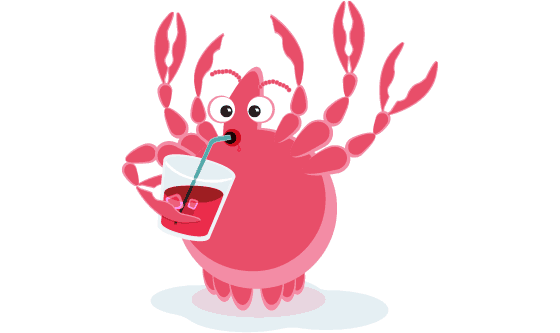
Pubic lice
Pubic lice are also known as ‘crabs’. Pubic lice are small parasites that dig underneath your skin, and feed on your blood.
If you’re infected, you can sometimes see them with your naked eye as tiny white dots on your pubic hair.
While annoying, crabs are curable.
How do you get pubic lice?
You can get pubic lice from sexual and non-sexual contact. Basically, crabs are spread from very close skin-to-skin contact or by intimate behaviours including sharing clothing, bedding, and sleeping bags.
You can’t get pubic lice by sitting on a toilet or from swimming pools.
How can you protect yourself against pubic lice?
1. Stop having sex with someone infected with pubic lice.
Unlike other STDs, condoms don’t protect against crabs.
2.Wash bedding, clothing, and other shared items in extremely hot water.
If you share bedding or clothing with an infected person, it’s important to wash these items in extremely hot water, at 60 degree Celsius or hotter. Items that can’t be washed, such as mattresses or cushions, dry clean them or seal items in a plastic bag for at least 72 hours.
In general, lice can’t survive without human skin for more than one to two days.
What are the signs that you’ve got pubic lice?
If you’re infected with pubic lice – commonly known as crabs – symptoms usually show up within two weeks after you are infected (but can appear between five days and seven weeks).
Sometimes, it’s possible to see pubic lice with the naked eye as tiny white dots at the base of your pubic hair. Lice can also be found on a moustache or beard, eyebrows, eyelashes, legs, or under the armpits. They particularly like to cling on to coarse hair.
Public lice symptoms include:
- Itching in the genital area
- Itching on the legs, chest, eyebrows, or under the armpits
- Visible tiny white dots (lice eggs)
- Visible crawling lice
- Red or brown spots on your underwear because of lice faeces
How do you get tested for pubic lice?
Go to your nearest health care provider for a diagnosis. They’ll probably look at your pubic area or other suspected areas with a magnifying glass to see if you’ve got live pubic lice, or ‘crabs’. Itchy red spots, dark brown spots (lice faeces) on your underwear, and tiny white dots among the hairs (lice eggs) are also signs of pubic lice.
How do you get rid of pubic lice?
Getting rid of pubic lice involves three steps: medication, washing infected items, and informing any sexual partners or people who’ve come into contact with your clothing and bedding.
1. Pubic lice medication.
Washing with ordinary soap won’t make a difference.
You can either get insecticide lotion or cream prescribed by your doctor, or buy an over-the-counter treatment.
Over-the-counter treatments generally contain either malathion or permethrin. Treatments containing malathion can be used for anyone over the age of six months. Permethrin lotion or cream is only advisable to use if you’re over 18. It isn’t advisable for pregnant women or breastfeeding mothers.
Both malathion and permethrin insecticide lotions or creams have similar instructions.
You have to apply the insecticide to the hair all over your body, after you’ve washed and dried yourself. This includes applying it to your scalp, face, eyebrow, ears, neck and moustache (if you’ve got one), as well as hair around your anus.
Avoid getting lotion in your eyes. If you do, use water to rinse your eyes thoroughly.
Leave the insecticide on your body for the time recommended in the instructions. After the recommended time has passed, wash it off thoroughly. And repeat again after seven days.
Remove nits (lice eggs) using a fine-toothed comb. Change into clean clothing and underwear.
2. Hot water washing
Wash any of your clothes that you wore before getting treatment and any of your bedding in water that’s 60° or hotter. If you can’t wash your clothes, either dry clean them or seal them in a plastic bag for 72 hours. Do the same thing with your mattress and pillows. Otherwise, you can become re-infected with lice.
3. Informing your sexual partners.
Tell your sexual partner(s) or anyone else that may have come into contact with your bedding, clothing, or towels to get tested and treated too. Otherwise, you may inadvertently end up getting pubic lice again.

Very good post! We are…
Very good post! We are linking to this great content on our site. Keep up the great writing.
We appreciate the feedback.
We appreciate the feedback.
Excellent post. Keep posting…
Excellent post. Keep posting such kind of information on your page. Im really impressed by it.
Thank you.
Thank you.
To add on to that Pubic Lice…
To add on to that Pubic Lice can easily be maintained. In the first place people must maintain cleanliness in the first steep,by taking showers frequently,shave pubic hairs to make the louses very visible easily. In the prosess of shaving they are scrub off. Alkaline from the soap helps killing their young ones,they like hiding under dundroughts < dead skins> .Never insecticide sprays on them that will affect your private parts.So I like you your page THANKS alot
Thank you for your…
Thank you for your contribution.